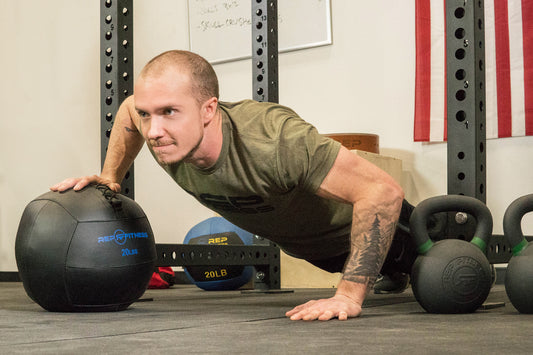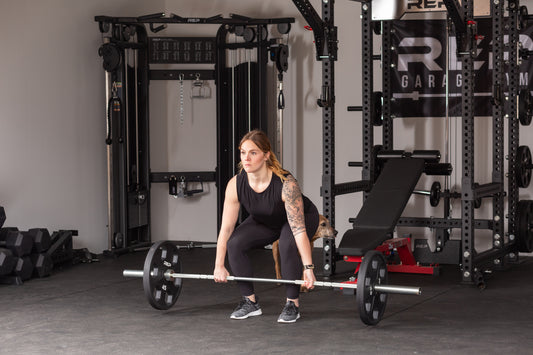
Just like any public space, the gym has its own etiquette – unspoken rules people follow to maintain order and express respect. But unlike a dinner table, many of the gym’s rules are a matter of safety. You don’t want to end up learning this etiquette the hard way.
Of course, not all barbell etiquette is about safety or even functionality. Some rules simply say, “Hey, I’m a baddie. I know what I’m doing here.” So yeah, you don’t have to follow every single rule. Unless you’re a barbell snob. Or want to impress other barbell snobs. Up to you.
Even if you’re a seasoned lifter, you may not know all the ways to treat the barbell properly. Here are 11 things to remember when working with barbells.
1. LOAD THE BAR PROPERLY

You may feel cool (and feel like you look stronger) by stacking 10s on 10s on 10s. But in truth, your barbell isn’t impressed. It puts less stress on your bar to use as few plates as possible. Not to mention, it’s heckin’ rude to hog all the smaller plates. Instead, if you can go up a plate size, do it – even if it’s a little extra loading and unloading. Consider it a little bonus workout.
Also, you’ll want to load the heaviest plates on the inside: 45s first, then 35s, 25s, 10s, you can do the math. This better distributes the weight by keeping the heaviest weight closer in on the bar. Going out of this order might make more experienced lifters dry heave a little bit. It’s just a no-no.
Powerlifters have their own preferences when loading a bar. When using single-sided plates, they like to place the first plates (usually 45s) facing inward and the rest facing outward. This makes it easier to see what’s loaded on the bar from various angles. Check out this video by Meg Squats on how to load like a boss.
2. UNLOAD THE BAR PROPERLY
Just as important as loading the bar properly is to unload it right. This one’s easier. If your bar’s racked, don’t take too much off one side at once, or your bar will flip and spill. If your bar’s on the floor, don’t be a monster and let the end of the barbell crash onto the floor as you pull off a plate. Use one hand to remove the weight and the other to kindly place the bar onto the ground all nice like. If you can’t coordinate that, ask for help or use a deadlift jack.
3. DON’T DROP AN EMPTY BAR

Never drop an empty bar. Dropping an empty barbell on the ground can damage the hardware inside, which can affect the spin or sleeves, damage the bearings/bushing, and break your barbell. Oof.
4. BE SMART WHEN YOU DROP A LOADED BAR
While you shouldn’t drop an empty bar, in instances of safety, it is OK to drop a bar if it has bumpers on it to help absorb the shock. Still, you always want to have control over your bar. Bumpers can bounce. Don’t bounce your bumpers in a busy gym. Keep your hands on the bar as much as possible so it doesn’t fly off into someone else’s personal bubble, and please, for the love of Odin, don’t walk away before the bar has stopped moving.
While you’ve probably seen weightlifters drop their bars, it’s actually not cool to drop weights every single rep out of convenience or because you’re a wee bit tired. Drop the bar only if you can’t safely lower it to the ground.
Avoid dropping the bar from overhead unless you fail the lift or lose balance. There’s a little more grace with dropping the bar from shoulder or waist level, but really, save it for when you’re fatigued. No reason to create unnecessary chaos by throwing things.
Note: Never drop barbells loaded with 10lb plates (or less). While REP’s 10lb bumpers are made sturdier than most, these small plates are really not meant to withstand that much impact and it can cause them to wear out sooner – and not protect your precious barbell.
5. BAIL SAFELY (IF YOU MUST)

Bailing a lift is different than dropping one. You sometimes see this with back squats -- to get out from underneath a heavy bar when the lift isn’t going as hoped. It’s best to lift in a power rack with safeties and reliable squatters and never need to bail. But if you find yourself in a doozy and must bail or get pinned, make sure you know how to properly do it.
Still. Don’t put yourself in this position; even a properly bailed barbell can be dangerous to yourself and people around you.
6. CLEAN UP AFTER YOURSELF
Yo mama taught you this when you were 4, and the rule stands. Clean the bar after you use it – even in your own home gym. Wipe off and sanitize blood and filth. Brush off chalk, which can make the bar rust. Don’t be gross. K thanks.
7. DON’T WALK IN FRONT OF A LIFT

This is especially true for weightlifters doing a big lift. It’s distracting (and also potentially dangerous, if they need to drop the bar or walk forward). Many lifters pick a cue – a spot on the wall, for example – to focus on while performing their lift. Not your big head.
8. BE RESPECTFUL OF OTHERS
Duh, right? Yet it’s easy to forget in the excitement of the gym. Always watch out for others. This includes not walking or standing on the platform someone else is lifting on, and not standing too close to someone getting ready for a lift (including behind them).
9. LOCK IN YOUR HIGH LIFTS

Some lifters don’t use collars when they’re benching heavy without safeties or spotters (never ideal); this opens up the emergency plan to dump the weight on one side rather than getting pinned under a fully loaded bar. But when you’re throwing weight overhead, make sure you properly secure the plates with clips so the weights don’t fly off. In fact, it’s smart to prevent falling weights for any lifts at or above shoulder height, including squats. Collar up, kids.
10. WATCH YOUR FEETS
Don’t put your shoes or bare feet on the barbell. You’ll actually get three reds (no lift) if you touch the bar with your foot on the platform at an IWF competition. One reason? The same reason you don’t want shoes on the table. Your shoes aren’t clean, and we put our hands on the bar.
Furthermore, in Slavic and Eastern European countries, it’s considered disrespectful to put your foot on the barbell – and even step over the bar (with no foot contact). It’s considered bad luck and offensive. Some say this etiquette even has religious and cultural ties.
11. DON’T SLAM YOUR BAR

We’ve all seen the bro intentionally slam the bar down like a caveman asserting dominance. Don’t be that guy. No matter how jazzed you are that you pulled that deadlift.
Control it. Respect it. Respect others around you.
In fact, controlling the negative (descent) of the deadlift is half the lift and reaps massive benefits. Save your barbell -- and save your face.

